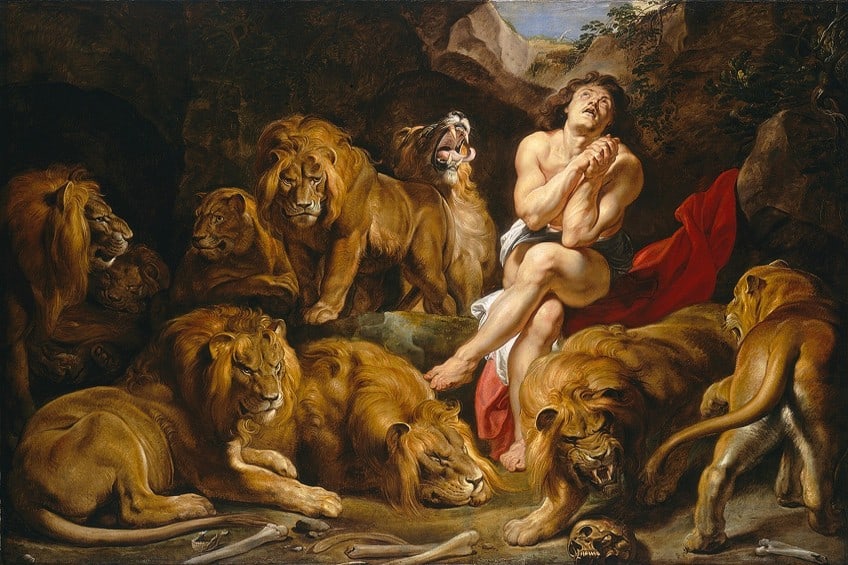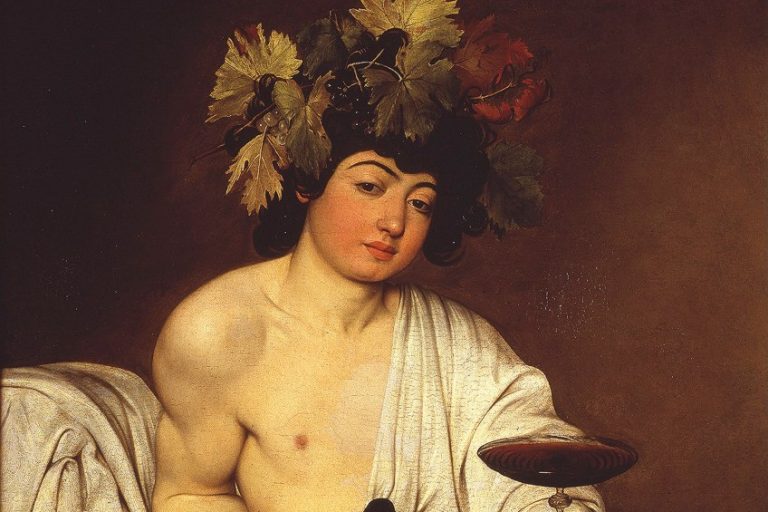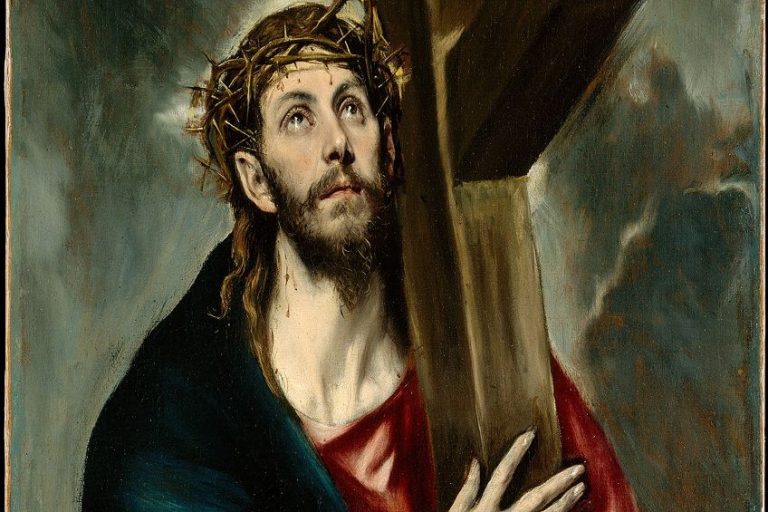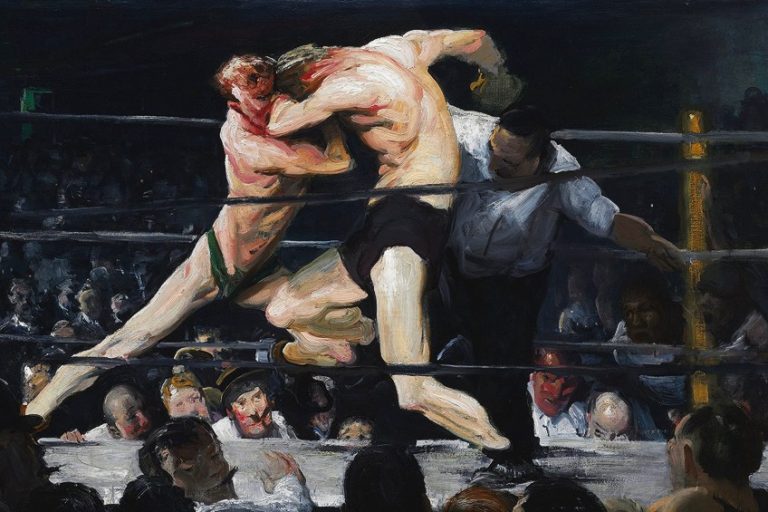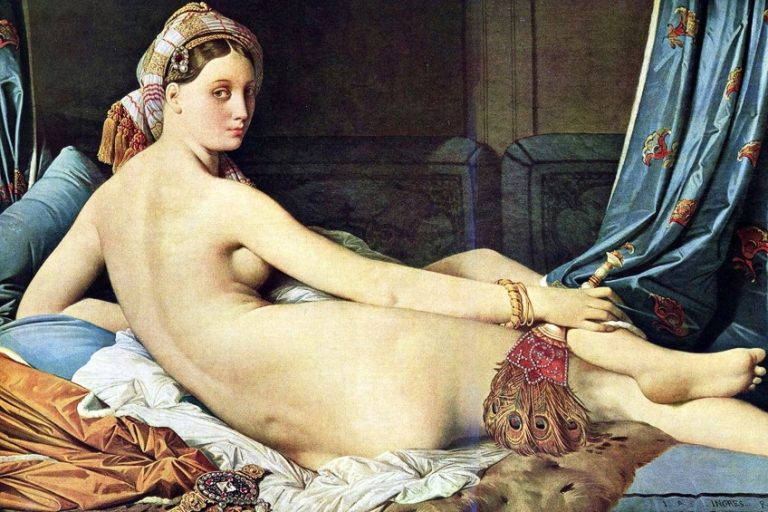“Daniel in the Lions’ Den” by Peter Paul Rubens – An Analysis
At first glance, the Daniel in the Lions’ Den (c. 1614 – 1616) painting by Peter Paul Rubens might appear to depict a Biblical tale, and although it does, there is a lot more to it than a show of faith. This article will discuss this painting, an often-depicted subject in art history, in more detail.
Artist Abstract: Who Was Peter Paul Rubens?
Sir Peter Paul Rubens’ birth date was on June 28, 1577, and his date of death was May 30, 1640. He was born in the city of Siegen in Germany and moved to Antwerp in 1587 with his mother, who was Maria Pypelinckx, (his father, who was Jan Rubens died in 1587).
In Antwerp, Rubens was taught classically and trained under teachers like Tobias Verhaecht, Adam van Noort, and Otto van Veen.

His art career spanned various commissions and he also painted for Vincenzo I Gonzaga the Duke of Mantua. His paintings were mainly of religious subject matter, but also included historical and mythological topics, hunting scenes, and portraiture. His style was characterized as Baroque.
Daniel in the Lions’ Den (c. 1614 – 1616) by Peter Paul Rubens in Context
| Artist | Sir Peter Paul Rubens (1577 – 1640) |
| Date Painted | c. 1614 – 1616 |
| Medium | Oil on canvas |
| Genre | Religious painting |
| Period / Movement | Baroque/Antwerp School |
| Dimensions (cm) | 224.2 x 330.5 |
| Series / Versions | N/A |
| Where Is It Housed? | The National Gallery of Art, Washington D.C., the United States of America |
| What It Is Worth | Price is uncertain; however, Peter Paul Rubens reportedly sold or exchanged the painting for a sculpture with Sir Dudley Carleton in 1618 |
In the contextual analysis below, we will look at Daniel in the Lions’ Den painting, when Peter Paul Rubens painted it, and why. We will also look at a formal analysis exploring how it was painted and what the art elements consist of.
Contextual Analysis: A Brief Socio-Historical Overview
Daniel in the Lions’ Den by Peter Paul Rubens was inspired by Chapter Six in the Book of Daniel (2nd Century BC) in the Old Testament of the Holy Bible. The story follows King Darius ordering Daniel into the lions’ den after he was found guilty of praying to God and not strictly King Darius.
Daniel was one of the king’s several, and highly regarded, assigned “administrators”, and because of his excellence, the king wanted to post Daniel as an administrator of the kingdom.
However, the other administrators devised a plan to sabotage his success and set forth a proposal to the king to create a decree that sentences anyone who worships another God other than King Darius to the lions’ den. When Daniel was shut in the den King Darius checked on him the following day and Daniel called out that the lions did not hurt him and that “My God sent his angel, and he shut the mouth of the lions”. Reportedly, Peter Paul Rubens depicted this scene of Daniel as he was discovered alive and well after spending the night with nine lions.

An interesting fact about Daniel’s figure is that Peter Paul Rubens also created a preparatory chalk-on-paper drawing of a young male for the figure of Daniel, titled Seated Male Youth (ca. 1613) and housed at the Morgan Library and Museum in Manhattan, New York City, the United States of America. Daniel was reportedly close to 80 years of age when this Biblical story took place, but Rubens depicted him as a younger, brawnier, man.
Reportedly, Rubens also had a model who posed as the young male figure, which is most probably why Rubens’ Daniel appears younger than the Biblical counterpart.
Daniel in the Lions’ Den Symbolism
There are several possible meanings of the Daniel in the Lions’ Den painting and one of which refers to martyrdom and Jesus Christ’s sacrifice and resurrection, which also acts as an inspirational tale of someone who has suffered, but through faith, endured the harsh challenges. Furthermore, Peter Paul Rubens painted Daniel in the Lions’ Den at a time when the Protestant Reformation was underway, and he was reportedly a Catholic.
His style has also been described as “Counter-Reformation art”, which was a means of visually portraying and telling stories that would evoke the Catholic faith.
Rubens Studying Lions
The lions that feature in Daniel in the Lions’ Den by Peter Paul Rubens were interestingly from North Africa and Morocco and are known as the Barbary lion. These lions were reportedly at what is known as the royal menagerie, which was in Brussels, and where Rubens had the opportunity to study them and make drawings. An example of one of Rubens’ drawings includes the black chalk and paper Lion (c. 1612 – 1613), which is also housed at the National Gallery of Art in Washington D.C., the United States of America.
Additionally, Rubens also traveled to Italy in the year 1600, which exposed him to the great artists of painting and sculpture from the Renaissance, for example, Titian, Leonardo da Vinci, Michelangelo, Raphael, and more.
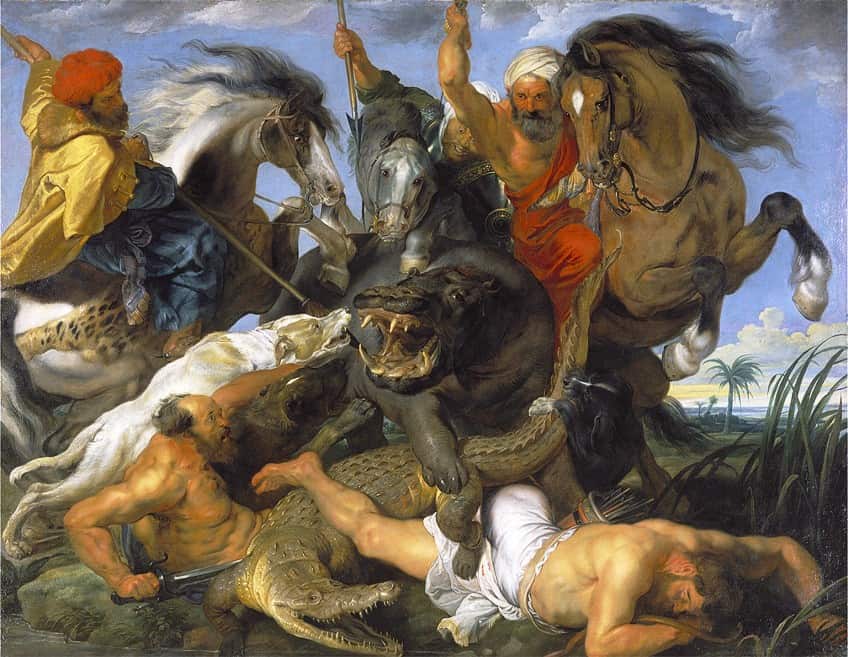
During his time in Italy, he also reportedly drew inspiration from animal sculptures, notably bronze sculptures, and some scholars believe from the Italian artist Agostino Carracci’s drawings. Some scholars also suggest that he studied the bronze sculpture Pacing Lion (c. 1590) by Giovanni Bologna, which is in the Kunsthistorisches Museum in Vienna, Austria, which is just one of many possible influencing lion imageries that inspired him to model his lions on.
It is also interesting to note that Rubens did not only depict lions in his paintings, but portrayed several different types of wild animals like horses, tigers, hippos, and crocodiles.
Examples include the oil on canvas Hippopotamus and Crocodile Hunt (1615 – 1616), which was commissioned by the Duke of Bavaria, Maximilian I. Some of Rubens’ other hunting scene paintings include namely The Tiger Hunt (1615 – 1616), The Wolf and Fox Hunt (c. 1616), The Wild Boar Hunt (c. 1618 – 1620), and The Lion Hunt (1621).
Formal Analysis: A Brief Compositional Overview
The formal analysis below will discuss the Daniel in the Lions’ Den painting further according to the art elements of color, texture, line, shape, form, and space. These are known as the “building blocks” of art and compose an artwork. They also work together with the art principles, which are known as the “principles of organization”.
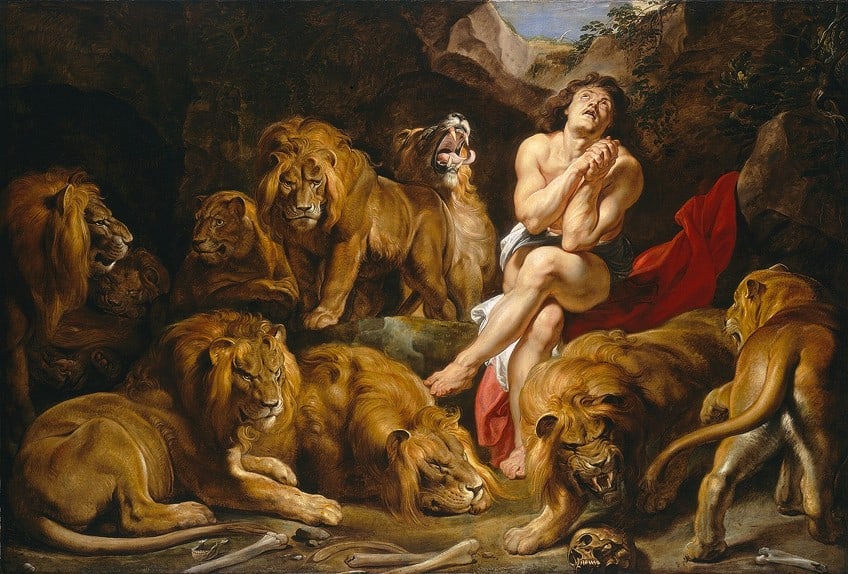
Subject Matter: Visual Description
Daniel in the Lions’ Den by Peter Paul Rubens depicts the figure of Daniel in a cavernous den surrounded by lions and lionesses. Daniel is situated more to the right of the composition, he sits on a rock that is covered by a large red piece of cloth, possibly from a robe, which further covers the rocks to his left (our right).
Daniel is semi-nude and only clothed around his waist, which is covered by a white cloth. He sits cross-legged (his left leg is over his right leg), and both his hands are clasped with interlocking fingers in a prayer position while his left elbow lightly rests on his upper left thigh.
His body and head are slightly rocked/tilted to his left (our right) and his upper back is hunched ever so slightly as he looks up at an opening in the rocky den above his head revealing a bit of blue sky. In the top right corner is what appears to be green foliage and greenery growing inside the cavern from the outside.
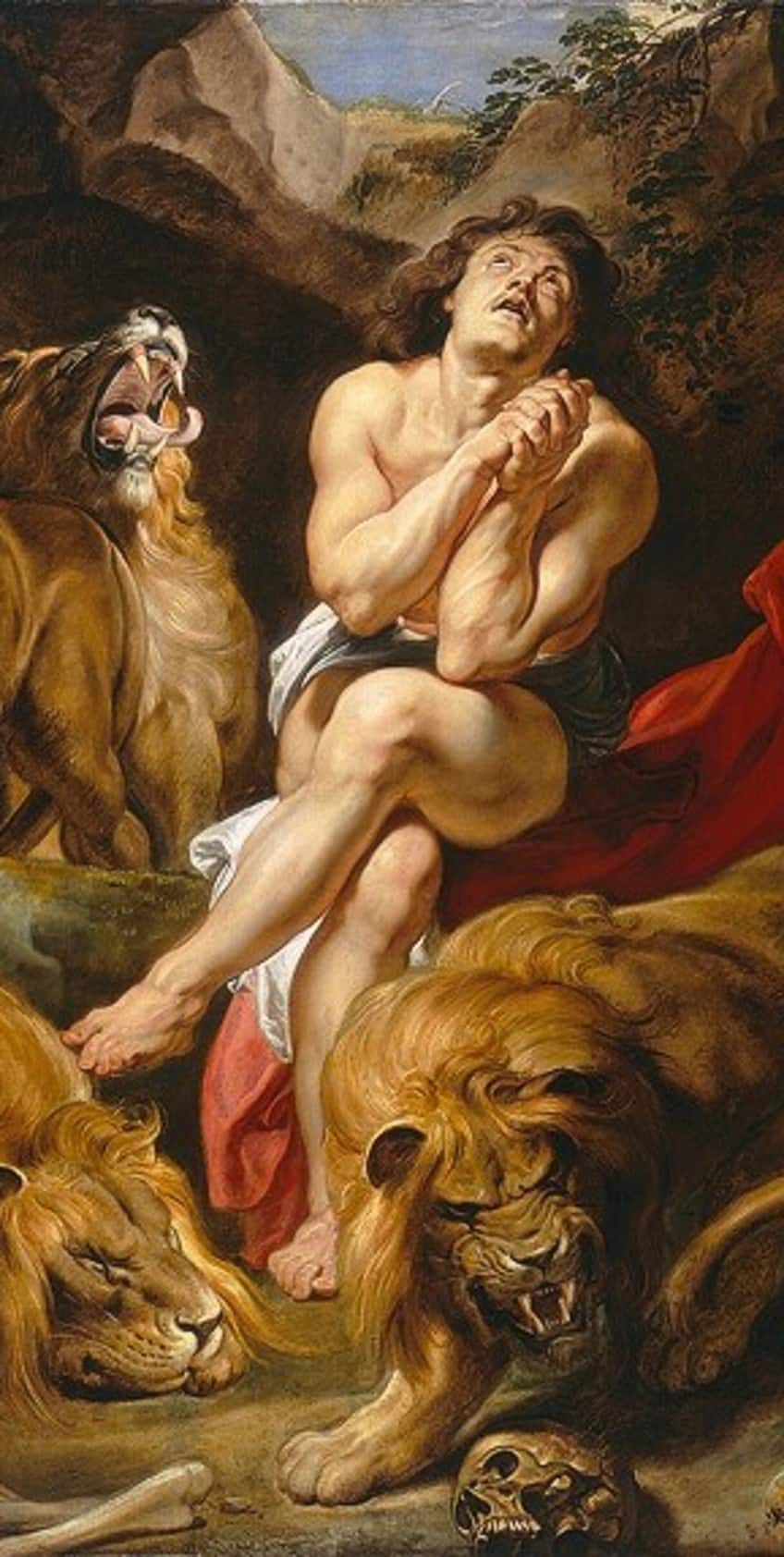
Daniel’s left foot’s two toes are lightly touching the lion sleeping to his right (our left) near his feet. This provides more dynamic tension in the scene indicating that Daniel is on the razor’s edge, so to say, but is still miraculously protected through his faith. There are ten lions, which include lionesses, and they are mainly situated to the left of the composition with two in the right foreground. Two lions lie in the left foreground while six are in the background.
An important question to consider when studying Rubens’ “Daniel in the Lions’ Den” painting is, “How many lions were in the den with Daniel?”, of which there are ten lions in the composition, which is often mistaken for nine. If you look closely at the sleeping lion in the left background, you will notice another sleeping lion almost underneath it, two lions curling up together.
Some of the lions are sleeping, walking around, sitting, or prowling while snarling. There is a lion to Daniel’s right (our left) in a full roar, revealing four large canines and its tongue lengthening out of its mouth, and in front of it is another, central, lion peering directly into our, the viewers, direction as if we are its prey. In the immediate foreground, there are several bones and what appears to be a human skull to the right, which heightens the dramatism and danger of the scene.
Color
Peter Paul Rubens utilized rich colors for Daniel in the Lions’ Den painting, from the lions’ golden-brown fur to Daniel’s peach skin tones and the red of the cloth he sits on. The color scheme is dominantly earthy colors, which also creates color harmony because there are no stark or clashing hues, however, the red from the cloth creates a focal point and emphasis. There is a clear contrast between light and dark, notably the area around Daniel, which appears lighter from the light source on him compared to the darker crevices towards the sides of the edges of the composition.
This contrast of light and dark creates a sense of depth and three-dimensionality and is referred to as chiaroscuro, which was a technique Rubens often utilized in his paintings.
Texture
Peter Paul Rubens created a rich variety of implied textures on Daniel in the Lions’ Den painting, which depicts it in a realistic manner. There are soft and smooth textures, for example, the lions’ soft fur, Daniel’s soft curly hair, and the smoothness of his skin, as well as the softer folds of the fabric.
These are contrasted with the rougher texture of the craggy rocks of the den.

Line
There is a variety of natural or organic lines utilized in Daniel in the Lions’ Den painting, which provide the fundamental forms for the subject matter. For example, the various curved lines, which are implied, in the lions’ forms as well as on the rock face of the den, of which the lines from the brushstrokes are also visible.
There is a diagonal line implied in the positioning of Daniel’s body posture, and the lean that is towards his left (our right), which creates more emphasis, coupled with the light source from above.
Shape and Form
There are mainly organic shapes and forms in Daniel in the Lions’ Den painting with various flowing and curved forms created by the natural and “free-flowing” shapes of the lions’ bodies and Daniel, who is sitting on the rock. The contrasts of light and dark also create three-dimensionality and depth in the various forms. Furthermore, Daniel’s body posture is slightly twisted, almost in an S-shape.
The rocky formation behind the figures in the foreground also appears naturalistic, but with more of a softer angularity compared to the fluidity of the human and animal figures.
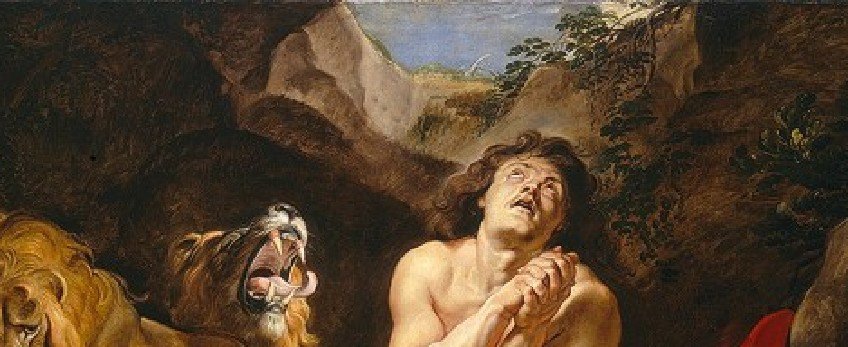
Space
If we look at how Peter Paul Rubens utilized his compositional space, he filled it with the main figures in the foreground and middle ground with the rocky face seemingly creating a backdrop effect for the action and movement in the foreground.
Furthermore, the direct foreground space is slightly open and leads us, the viewers, into the scene, as if we are included in the den with Daniel.
Rubens: The Heart of a Lion
In this article, we discussed Daniel in the Lions’ Den painting and touched on several of its key features, as well as the formal visual elements that make it the masterpiece it still is today, and we know that it was a product of Peter Paul Rubens’ rich art career and outlook, which included his many life experiences buoyed by his wealth of social and political exposures.
https://www.youtube.com/watch?v=PV4GQjgHp8s
Peter Paul Rubens was one of the foremost Baroque artists and left a legacy throughout art history, known for his dramatic and boldly colored scenes. He was known to have had apprentices who assisted in creating his paintings, but many artworks he painted himself, which includes “Daniel in the Lions’ Den”. Although Rubens painted many other wild animals and hunting scenes, “Daniel in the Lions’ Den” places a figure who was bound by a level of infinite faith as the central protagonist, and through the depiction of Daniel, Rubens encapsulated the heart of a lion amongst the lions.
Take a look at our Daniel in the Lions’ Den painting webstory here!
Frequently Asked Questions
Who Painted Daniel in the Lions’ Den?
The Baroque artist Peter Paul Rubens painted Daniel in the Lions’ Den around 1614 to 1616. It is an oil on canvas measuring 224.2 x 330.5 centimeters. It depicts the Biblical tale of Daniel who survived in a den with lions.
Where Is the Daniel in the Lions’ Den Painting?
The Daniel in the Lions’ Den painting is housed at the National Gallery of Art, Washington D.C., the United States of America, which acquired it in 1965. It was reportedly bought from M. Knoedler, who was an art dealer.
How Many Lions Were in the Den With Daniel?
There are ten lions depicted in the Daniel in the Lions’ Den painting by Peter Paul Rubens, however, sometimes it can be confused for nine. There are two lions sleeping in the left background, which can appear as one.
Alicia du Plessis is a multidisciplinary writer. She completed her Bachelor of Arts degree, majoring in Art History and Classical Civilization, as well as two Honors, namely, in Art History and Education and Development, at the University of KwaZulu-Natal, South Africa. For her main Honors project in Art History, she explored perceptions of the San Bushmen’s identity and the concept of the “Other”. She has also looked at the use of photography in art and how it has been used to portray people’s lives.
Alicia’s other areas of interest in Art History include the process of writing about Art History and how to analyze paintings. Some of her favorite art movements include Impressionism and German Expressionism. She is yet to complete her Masters in Art History (she would like to do this abroad in Europe) having given it some time to first develop more professional experience with the interest to one day lecture it too.
Alicia has been working for artincontext.com since 2021 as an author and art history expert. She has specialized in painting analysis and is covering most of our painting analysis.
Learn more about Alicia du Plessis and the Art in Context Team.
Cite this Article
Alicia, du Plessis, ““Daniel in the Lions’ Den” by Peter Paul Rubens – An Analysis.” Art in Context. March 10, 2023. URL: https://artincontext.org/daniel-in-the-lions-den-by-peter-paul-rubens/
du Plessis, A. (2023, 10 March). “Daniel in the Lions’ Den” by Peter Paul Rubens – An Analysis. Art in Context. https://artincontext.org/daniel-in-the-lions-den-by-peter-paul-rubens/
du Plessis, Alicia. ““Daniel in the Lions’ Den” by Peter Paul Rubens – An Analysis.” Art in Context, March 10, 2023. https://artincontext.org/daniel-in-the-lions-den-by-peter-paul-rubens/.


